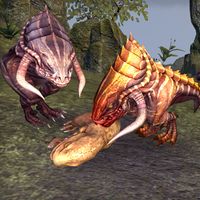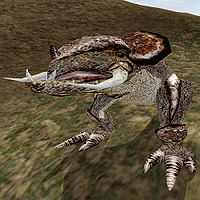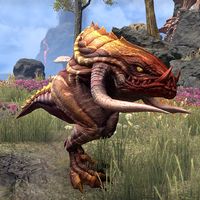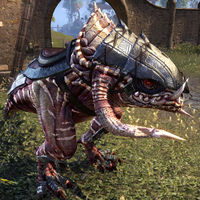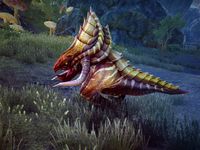Lore:Kagouti
| Kagouti | |||
|---|---|---|---|
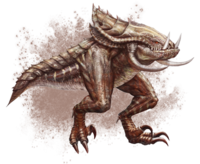 A Kagouti
A Kagouti |
|||
| Type | Beast (Reptile) | ||
| Range | Black Marsh, Craglorn, Morrowind | ||
| Appears in | |||
Kagouti are large, armored bipedal reptiles, related to alits, guar, and wormmouths,[1] that are native to Morrowind. Their defining features are their large tusks and the thick crests on their heads. Kagouti have a large number of teeth, sometimes growing a second or even third pair of fangs depending on age.[2]
Like many wild beasts, Kagouti can be infected with diseases or parasites like Yellow Tick, and can transmit them to people they attack.[3]
Behavior and Diet[edit]
Normally solitary like the Alit, kagouti usually travel on their lonesome, with the exceptions being family units, rich food sources (be it foraging, scavenging, or hunting), or the mating season, where they can gather in large numbers. Despite often being larger and more vibrant in color than the smaller and duller-colored females, males are not the dominant sex during courtship, and are sometimes attacked when they gift food to their partners while wooing them. Males will, however, turn violent and rush to the defense of the smaller females when they are threatened.[4] Likewise, when mating has concluded and the females have lain their clutches, it is the males that are left to hatch and rear the calves.[5]
Among themselves, the males are surprisingly less violent, and normally do not fight with each other for reproductive rights; instead engaging in posturing to avoid injury, and stake a claim over territory and a harem, reinforced by loud calling, particularly at night. This is not always the case though, as violent and fatal clashes can and, rarely, do occur.[6] When it comes to other species, however, both sexes experience heightened aggression during mating season, and often attack intruders that get too close.[7] It is ill-advised to do so, as Kagouti are capable of tossing a grown mortal into the air with ease.[8]
Just as the other members of their family, Kagouti are omnivores, that will eat anything they find palatable and can fit in their mouths, be it plant matter, or unfortunate victims.[9]
Variants[edit]
There are several variants of kagouti, but the most widespread species, the Least Kagouti,[10] is easily recognizable; pale pinkish-white as calves and subadults, often darkening as they age, with males obtaining vibrant patterns of reds, oranges, and yellows as they reach maturity and become bulls.[11] The Chalkhide Kagouti, however, native to the Deshaan region, bears a dappled hide of white, black, and gray that aids it in blending into the rocks of its home territory. Its behavior also differs from most other species as well, as it favors ambush hunting over direct and brute-force attacks.[12]
Uses and Culture[edit]
Kagouti horns and tusks can be used to make a variety of goods.[13] Powdered kagouti horn is rumored to heighten potency, and the ribs are used as an exotic ingredient for meals.[14][15] Their hide is used to make clothing, armor and household goods, and can also be utilized in alchemy.[16][17][18]
Kagouti meat is edible and used in Dunmer cuisine. Kagouti Steak is a meal can serve about 12 people, the recipe calls for the haunches but the rest of the legs and calves can do if a few more steaks are needed. These have the largest sections of meat and are tender in younger kagouti.[UOL 1]
The domestication of kagouti as mounts was considered a recent and experimental development circa 2E 582.[19]
Gallery[edit]
References[edit]
- ^ Esqoo of Dhalmora Answers Your Questions — Esqoo of Dhalmora
- ^ Agents and Reagents: The Bounty of Mundus: Ingredient Classification 16: Lizard Parts
- ^ Kagouti in Morrowind
- ^ Huntmaster Sorim-Nakar's dialogue in ESO
- ^ Zainsipilu in ESO
- ^ Short-Tusk's Hillock in ESO
- ^ Kagouti Mating Habits — Edras Oril
- ^ Morrowind Fauna, Part One — Holia Asellio
- ^ Veenaza's dialogue in ESO
- ^ Yellow Tick description in Morrowind
- ^ Bull Kagouti in ESO
- ^ Chalkhide Kagouti in ESO
- ^ Ceremonial Drinking Horn, Kagouti Tusk Drinking Cups and Kagouti Drinking Horn item descriptions in ESO
- ^ Doubts-the-Moon's dialogue during Unwelcome Guests in ESO
- ^ Veenaza's dialogue in ESO
- ^ Generic dialogue on the topic of Kagouti Hide in Morrowind
- ^ Kagouti Hide in Morrowind
- ^ Kagouti Hide in Skyrim
- ^ Kagouti mount description in ESO
Note: The following references are considered to be unofficial sources. They are included to round off this article and may not be authoritative or conclusive.
- ^ Recipes from Vvardenfell — Various
